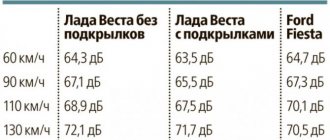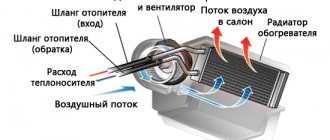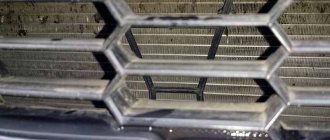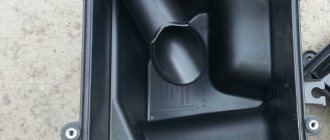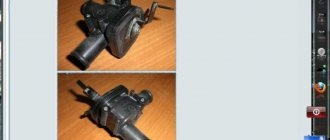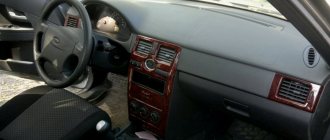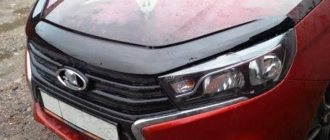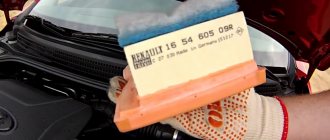Protection of the cooling radiator in the form of a mesh protects it from dirt. Thermal protection serves to insulate the engine so that it cools down more slowly. Lada Vesta is equipped with a beautiful plastic grille that covers the radiator. Nice large cells are capable of letting a lot of dirt, sand, and insects through, which quickly clog the radiator. Therefore, motorists install an additional fine mesh. Before closing the Vesta radiator, you will need to partially disassemble the upper part of the bumper.
There are still disputes among motorists...
... regarding the advisability of insulating the engine compartment in winter. Many drivers are guided by the climatic features of the region in which the vehicle is operated.
If the average temperature does not exceed -15°, then the winter grille does not need to be installed. When the temperature drops below, insulation is mandatory.
Also, installation of a “winter plug” is necessary in case of long trips on country roads, when temperature changes are possible literally at every kilometer.
Insulating the radiator for the winter is an individual choice of the driver. Analyze the mode of use of the car and make a decision.
Problems that arise during the cold season
Lack of a high level of heating of the stove. At ambient temperatures below -10 degrees, the Lada vesta sw cross heats the interior only at the last mark of the scale. In this case, operation of the heating device at maximum requires turning off the heater fan.
Vesta starts up without problems in winter, but the engine is brought into working condition only from the second or third revolutions of the starter. Low quality door seals. A Vesta covered in snow does not provide reliable protection against snow getting inside the cabin. Car owners note shortcomings in the windshield cleaning system. The modern system provides fast, effective glass cleaning and saves glass washer fluid. Disadvantage: lack of heating function. The lack of a steering wheel heating function causes discomfort when driving in the morning in a car that has frozen overnight. The Vesta's front seat heating function does not have a medium mode; it is either maximum or absent altogether. To prevent your vehicle from failing on the highway while driving in winter, prepare it for the cold.
How to insulate an engine in winter
In order for the Lada Vesta engine to warm up at sub-zero temperatures as quickly as possible, drivers often close the radiator grille from oncoming air flow in various ways.
When deciding how to insulate a radiator, some buy ready-made devices, while others make them on their own.
The following types of grille plugs are available:
- upper and lower covers for the radiator grille for winter, costing from 500 to 1000 rubles;
- mask - insulation (apron), costing 1500-2000 rubles;
- homemade devices from improvised materials (plywood, cardboard).
Reviews
| № | Positive |
| 1 | Andrey (Avtodrom): I bought the cars a year ago and realized that I couldn’t do it without the pad. I’ll stop by the service station, find out prices, and order installation. |
| 2 | Sergey (Avtotema): I ordered the installation of the cover, the guys did everything promptly, no comments. |
| 3 | Kirill (Autoreview): I’m happy with the cover, now the radiator is safe. My recommendations to motorists. |
| 4 | Alexey (Avtoria): installed the protection last summer, a year has already passed. There are no comments, it keeps warm. |
| 5 | Alexander (Drom): I installed the overlay myself, everything took half an hour. Everything is simple and logical. |
| 6 | Stanislav (Behind the wheel): temperatures in winter are high, insulation has repeatedly helped out. |
| 7 | Vasily Alekseevich (“5th wheel”): thanks to the insulation, in winter the engine starts with a half turn. |
| Negative | |
| 8 | Vitaly (Avtotema): installed an apron, after the “slurry” it picks up moisture and scratches the paintwork. |
| 9 | Svyatoslav (Otzovik.net): I installed the winter lining, but it started knocking on rough roads. My comrades advised me to disassemble it and install a sealant. |
| 10 | Vlad (ProAvto): installed the cover from the outside, was dissatisfied, weak fixation. |
Related link:
Advice from mechanics on replacing brake discs on a Lada Vesta.
Dressing the car for winter
At low temperatures, the car engine consumes more fuel and acceleration dynamics decrease. To prevent increased consumption, some owners install a solid plastic plate on the front of the radiator grille.
Due to the use of such an accessory, heat is retained longer, the internal combustion engine cools more slowly, and fuel consumption is stabilized. The winter lining, like the summer one, consists of three parts: upper, lower and grille for air intakes.
If the frosts are insignificant, then the upper part can be temporarily removed so as not to “drive” the cooling system fan. The cover is attached to plastic clips and two screws.
Homemade insulation
Cutting strips onto the grill is a compromise option with minimal cost. A training mat, rubber, insulation, and other analogues are used as a basis.
Which radiator grille to choose for Lada Vesta
AvtoVAZ engineers offer several options for modifying the radiator grille for the winter:
- branded model from AvtoVAZ;
- overlay in the “winter-summer” style is a universal type.
Branded radiator protection
An analogue of the standard summer-type pad, only without cells (honeycombs), is a proprietary protection made of impact-resistant plastic. The AvtoVAZ logo is located on the front. Installation is carried out using plastic clips and screws.
Universal
The upper and lower polymer pads are installed on top of the standard mesh and fixed with self-tapping screws.
The main advantage of the “station wagon” from the original is that the trim can be easily removed without removing the bumper.
Video about the modifications carried out after removing the Kalina-2 bumper
https://youtube.com/watch?v=amJLyrIrsps
Radiator protection for Lada Kalina-2, with polymer coating, high quality at an attractive price Radiator protection for Lada Kalina-2, from “Prozzz customz”, for only RUB. We guarantee timely delivery throughout the Russian Federation and quality of goods
Radiator protection for Lada Kalina-2 - reliable protection of your radiator from rubble, birds, large insects, etc., except for pillars and bollards, oncoming traffic and other “minor” troubles.
Material: steel mesh, honeycomb type cell, in a metal frame, with a polymer coating against corrosion
Installed externally on the radiator trim (bumper grille), attached to the standard grille.
Kit: top mesh, bottom mesh, fasteners, installation instructions.
Manufacturer: Prozzz customz. Togliatti.
Sending by transport company: YES is possible.
Owners of Lada Kalina 2, who want their car to stand out among hundreds of others, usually resort to tuning, which involves repainting the body, installing spoilers or bumpers.
The latter may occur for reasons such as:
- flying insects;
- ingress of plant fluff;
- impacts of stones flying from under the wheels.
Protective mesh for the LADA Kalina 2 radiator.
A special feature of the Lada Kalina 2 is that in it the radiator, which is responsible for cooling the engine, is located almost at the same level with the front bumper. A radiator with large cells should protect the fins of the heat exchanger. Because of this, despite the fact that the grille protection is made of aluminum or steel, many Lada owners install additional protection on it in the form of a fine-pitch mesh. Such products have different shapes.
Despite the laboriousness of the operation, based on all the available methods for tuning the Lada Kalina 2, this method is one of the most inexpensive. With the proper culture of using certain tools, it can be done with your own hands. The end result makes the Lada's exterior more aggressive and powerful.
Chrome mesh for the radiator grill of Kalina 2
Installation of winter protection for Lada Vesta radiator
Preparation of the workplace, necessary tools:
- key for “10”, “12”, knob;
- Phillips head screwdriver;
- a lining on the floor to prevent scratching the paintwork of the bumper;
- additional lighting if work is carried out in the dark.
Installation of a plastic product requires considerable effort, accuracy and labor intensity. Use an assistant to complete the work.
Algorithm of actions:
- We place the car above the inspection hole to provide access to the bottom.
- Open the hood, remove the engine sump protection and license plate.
- We gradually unscrew the fasteners of the upper, middle, and lower contours.
- We remove the headlight units from the seat.
- We move on to the wheel arches and unscrew the bolts.
- When the front bumper is completely freed from the fasteners, dismantle it and place it on a soft surface to avoid damage to the paintwork.
- Using a TORX wrench, unscrew six bolts in the upper perimeter and four in the lower perimeter.
- We dismantle the grille, first unfastening the plastic latches.
- We insert the winter grille, screw the upper and lower fastenings.
- We assemble the front bumper in reverse order.
DIY installation is complete.
Installing the hood seal
The rubber band from the factory is installed only in the center, and there is nothing at the edges. Why couldn't it be done around the entire perimeter? The car would cost 500 rubles more, but it would be clean under the hood!
Let's glue some 2mm construction sealant here.
But first we degrease the surface with a special degreaser, and then warm it up. After that, everything is easily glued and looks like this.
There is nothing complicated, just take it and glue it. The main thing is to degrease thoroughly. The result is great. After this, it will be much cleaner under the hood. We will put all minor issues in order.
Conclusion
It is necessary to install Lada Vesta radiator insulation for the winter. Each car enthusiast chooses the type and modification of the accessory individually.
The branded overlay from AvtoVAZ is relevant in case of long-term operation of the car in harsh climatic conditions. Universal protection is more applicable for temperature conditions in the CIS, including the Russian Federation.
A homemade kit is an economical insulation option when you need to close the radiator from frost as quickly as possible.
The radiator protection of the Lada Vesta car is used to protect it from dirt, and the grille insulation is used so that the engine cools down more slowly and the winter cold is unaffected. The Lada Vesta has a nice plastic radiator grille. It has large cells, design has defeated rationality. Over time, the honeycombs of the cooling system will become clogged with all sorts of rubbish: sand, dirt, flies and beetles, ending with fine gravel, which causes significant damage to the car’s radiator. It is advisable to modify the factory radiator mesh with an additional mesh. Read the article and find out how to protect and insulate your radiator grille.
Disadvantages of Vesta chip tuning
What could be the disadvantages of this process? Typically, owners of a domestic model are concerned about the life of the power unit and maintaining the factory warranty.
Is Vesta's engine life decreasing?
During surveys, almost all tuners claim that the resource remains the same. However, no serious research has been carried out in this direction. After all, this is expensive from a financial point of view, and the sample would be very significant - at least several hundred cars. For this reason, it is easier to make a statement that there is no negative impact.
However, logic dictates that if you conduct an experiment and put 2 identical engines on the stand - one chipped and the other not - and run them at maximum power when the throttle is fully open, then the chipped engine should wear out faster.
In light of this, some studios admit that a decrease in resource does indeed occur, but it is extremely insignificant - no more than 5%, so you should not dwell on it. In the end, refueling with low-quality gasoline can harm the Vesta engine much more than adjusting the software. However, all this is true only for high-quality software.
However, we should not forget that boosting the engine, even if it is electronic, affects its torque, which increases the load on the gearbox. This is especially true for the AMT robotic transmission of the Lada Vesta. As a result, you will also have to change the settings of the AMT and other electronic units, which significantly complicates the process.
Is it possible to lose the factory warranty?
Yes, you can. Although all the studios will claim the opposite, claiming that their software is impossible to detect. However, it is not. Of course, during scheduled maintenance at the dealer, no one will connect to the engine, and even in the case of a warranty claim related to the chassis. However, if there is a breakdown of the engine or transmission, the dealership technician will probably connect the computer to the Vesta ECU and detect the use of other software. This may be a reason to void the warranty. The only way out is to preserve the standard software and install it without fail instead of the chipped software before undergoing maintenance. But even this does not give a 100% result.
Branded radiator protection
Designed specifically for Lada Vesta. Summer protection is made of a 4-component set for the radiator grille + two air intake elements. Made of durable aluminum, the protective mesh has optimal holes and is nicely edged with plastic. In the kit, the manufacturer has provided all the necessary supplies, from instructions to a screwdriver. Fastening is done using latches, the description in the instructions is extremely clear, you don’t need to remove or disassemble anything to install the protective grilles. Simple manipulations, and the car becomes prettier right before your eyes. Installation - at temperatures >+10 degrees Celsius. Looks effective. Minus - a little expensive.
Let's look under the bottom - replacing the engine protection
No matter what anyone says, progress is felt, there are many innovations. The rear springs are separate from the struts; now you can easily change them and experiment with them every day. Very convenient for repairs.
We looked under the car for a reason, but to replace the standard thin protection with a stronger steel one. The factory protection is made of aluminum, and is too weak, it will not protect against anything. Let's replace it with serious new armor.
What are the subtleties? Take the armor, and along with it the largest possible washers for secure fastening. Some craftsmen say that there is no need to remove the standard aluminum sheet. But I recommend removing it, since it does not provide anything, and even more so, it will rattle and rattle as you go.
Universal
This cover for the VAZ 2180 radiator will cost less, but the mesh is installed from the inside, you need to take the trouble to disassemble it. You can't do it without removing the bumper with the standard plastic grille; you'll have to do some work. What distinguishes this method of protection from the cheapest version of protecting a car’s cooling system is the presence of an edging around the mesh fastenings (brackets). Choice by article number: VS-ZSRLVES or ZR.LAD.VES.15
. It is called “Arrow” and is installed at the top of the bumper and down.
The price of such a mesh, upper and lower, in a set, is about 3,000 rubles. You can find them cheaper separately.
Does the West antifreeze leak in winter?
Car enthusiasts of AvtoVAZ models note leakage of antifreeze in winter, especially in severe frosts. This happens because in severe frosts the rubberized seals and tubes become deformed. If the driver notices a leak, it is necessary to find out the cause and source of the defect. As a last resort, you will have to install a new thermostat and add antifreeze.
Do it yourself - how to make protection anyway
For garage Samodelkin, saving budget, manufacturers have prepared an extremely inexpensive option for protecting the cooling radiator. This is an aluminum mesh, which should be independently attached to the plastic grille and bumper from the inside. The cell size is usually 10-15 mm. The cost is much cheaper than branded, universal ones for the Lada Vesta, purely a cover without frills and claims to classic tuning. Garage technicians will have to scratch their heads trying to figure out how best to mount this thing. It is necessary to take two pieces of mesh, the sizes sold are as follows, for a couple of parts (grille and air intake), there is unlikely to be enough material.
The most common Vesta suspension failures
If the Lada Vesta suspension is knocking, then the reason, first of all, should be sought in the shock absorbers; they are the ones that most often cause such sounds. If you decide to check the integrity of the shock absorbers yourself, then hurry to do this immediately after stopping so that the liquid in them does not have time to cool. Rock the car; a good shock absorber will not allow the body to oscillate more than 2-3 times.
Another reason for “incomprehensible” knocking noises may be wheel bearing play. To check the play, you need to hang the wheel and shake it from side to side. If the wheel play is large, then it is time to change the bearing.
Owners who often use Vesta on dirt roads often hear a creaking noise coming from the rear suspension. Most likely, it is caused by foreign objects (small stones, etc.) getting between the brake pads and the disc.
How can you determine which suspension on the Lada Vesta is reliable or not? Only time will tell, because the car is quite new and still quite “untested”. Accurate conclusions can only be drawn after many years of operation. In the meantime, one thing can be said with confidence - the suspension is decent, and allows you to fully experience the advantages of the Lada Vesta car.
Dressing the car for winter
In winter, in the northern expanses, severe Siberian frosts, the car eats gasoline more actively and freezes faster than you want. It is advisable to insulate the car for winter to feel more comfortable. Attempts to insert a cardboard do not go well; you cannot insert a cardboard into a Lada vesta, and to cover it on top is a “collective farm”. We have to turn to ready-made insulation solutions.
Insulation from YarPlast code: VS-ZIM-Z
lower price: from 550 rub. The top one will cost from 890 rubles.
The winter radiator protection is made of strong black plastic; it fits into the interior of the Lada Vesta and does not disturb the harmony. The engine temperature rises quickly, it cools down more slowly - it uses gasoline more economically. This insulation, like summer insulation, consists of two parts: for the grille and the air intake. When it thaws, it is better to remove the top part if you do not want to drive in the fan. There shouldn't be any problems installing this device; it's fastened with clips and standard bolts. It is recommended to apply adhesive tape or insulating tape to the bumper in the place where the lower part of the shield may come into contact, stripping off the paint.
Review of product prices for LADA Vesta
Price is an important criterion when choosing parts for tuning; it often affects the quality of the product and its durability. Let's consider the most optimal products in terms of price-quality ratio.
- YAROPLAST winter grilles consist of two elements. One of them is for the lower grille, the other for the upper protection.
Cost – 600 rub. and 900 rubles, respectively. This is a high-quality product that allows you to completely block the oncoming flow of air masses for the radiator. If the air temperature drops below 3-4 °C below zero, it is better to remove the upper part of the structure so that the cooling fan does not turn on too often.
- Icarus-VENERA.
Designed for top-end vehicles, installed in place of the factory design. All other configurations can be upgraded with a product with article number 8450008876. The cost is about 1,700 rubles.
- Chromed bottom trims.
For manufacturing, they use polished stainless steel, which is not susceptible to corrosion, and it can be installed on top of the standard system. A quality product costs about 5,000 rubles.
- External mesh for radiator.
An alternative solution for those who decide to abandon metal mesh. You can install it yourself on the inside of the bumper in just five minutes. For the edging of the protection, soft black plastic is used, secured with clamps. A high-quality bottom set will cost 2,300 rubles, an upper set will cost 3,300 rubles, a winter set for the bottom costs 650 rubles, and an upper set will cost 1,000 rubles. Winter covers can only be installed on protective nets.
- Linings produced by FERRUM-GROUP.
High-quality products that have many positive reviews. Cost from 1850 rub. up to 2850 rub.
- Another stylish tuning is an emblem for the Vesta radiator grill; it will cost from 300 to 1000 rubles.
| Manufacturer | Price |
| ICAR-VENERA | 1650 – 1730 rub. |
| YAROPLAST | 1400 – 1600 rub. set top, bottom |
| FERRUM-GROUP | 1700-2900 rub. |
| Chrome protection | From 4500 rub. |
| External structures | 2000 to 3500 |
| Winter external protection | 1630-1650 rub. set |
*prices are current as of October 10, 2018.
Experts do not advise purchasing the cheapest goods, since they are not of good quality; it is better to choose an average cost and a trusted manufacturer. For example, products produced by FERRUM-GROUP have good characteristics.
List of online stores
https://ladatuningshop.ru/reshetka-radiatora-lyuks-bez-znachka-dlya-lada-vesta
Yaroslav: “I needed a radiator grille for Vesta, tuning - I decided to buy it in this store. I was pleased with everything - the price was reasonable, the goods arrived whole, not broken.”
Max: “Problems with delivery, they promised to send it right away, they sent it in a week. I called and asked what the reason was - they said they were out of stock and were waiting for delivery.”
Sergey: “Quality product, good material, but it came to me with two scratches on the left side of the part.”
https://lada-vesta-shop.ru/shop/tyuning/reshetka-radiatora-ikar-dlja-lada-vesta.html
Artem: “On weekends it is impossible to contact the store - this is very inconvenient, since on weekdays there is simply no time for conversations.”
Alexander: “The product fit perfectly - I talked to the seller by phone, he helped me choose the size of protection, told me all the characteristics - a good store.”
Nikita: “A large selection of different parts for Vesta, I found not only protection, but also many other things necessary.”
https://rs-motor.ru/vneshniy-tuning/reshetki-radiatora/vesta-lyuks
Dima: “I’ve already ordered goods for my car from this store twice, they always arrive quickly, the delivery is good, and the quality is excellent.”
Matvey: “I ordered a Lada Vesta radiator grill here and decided to do the tuning. It arrived beautiful, good, I can’t say anything, but the price turned out to be higher than what I later saw in our car market.”
Denis: “I am satisfied with the speed of delivery, the speed of order processing, the quality of the goods - there are no complaints about the seller.”
https://avtoform-plast.ru/catalog/reshetki_radiatora_top/product_12568/
Stas: “I called a store representative, received high-quality advice, they advised me on both the size and characteristics of the product - I was pleased with the seller’s work.”
Egor: “The materials and products are really high quality, worth the money. The seller actually sends original parts, verified.”
Grigory: “I waited for delivery for two weeks - that’s quite a long time, although in the conversation they promised that the goods would be available tomorrow, in fact it arrived five days after the conversation.”
Which radiator grille for Vesta to choose
The radiator grille of the Lada Vesta without a badge decorates the appearance. The domestic car looks like it came from Europe. Removing the emblem from the front surface of the hood requires replacing the grille.
AvtoVAZ offers several options for grilles for Vesta.
Grate for the cold season. Consists of two components. Protects against penetration of cold air masses into the radiator. Estimated cost – 1200-1500 rubles. Replacement is carried out at an air temperature of at least -3 degrees.
External tuning of Vesta
Regardless of what configuration of the Lada and in what body this car is presented, tuning begins with external changes to the exterior. A typical external tuning may consist of the following stages:
- Installation of plastic linings on the doors, roof and trunk of a car. Today you can find a wide variety of versions of this decorative element: spoilers, protective covers on the side panels, hood deflector. In addition, there are sets of wheel arch extensions, side doors and hood deflectors designed for Lada Vesta.
- A classic of the genre is the installation of large diameter wheels and stylish rims. Exclusive “boots” are a distinctive detail of any tuning, especially if it concerns the pride of the domestic automobile industry.
- Variations of front and rear optics. You can do this step yourself by installing simple or original trims, or you can purchase unusual fog lights or LEDs. This styling is very popular.
- Full or partial tinting is a distinctive feature of the tuned Lada Vesta.
The photo of the Lada Vesta tuning perfectly demonstrates the scope of the designer’s imagination. This car, like no other, is easy to change and only gets better thanks to innovations regarding its appearance. The Lada Vesta tuning video will help make the classic version of the car more original and unusual.
The financial component depends on the set of “additional options” selected. Below is the cost:
| Name | Approximate price, rub. |
| Standard black mudguards | 1200 |
| Gas struts for hood | 2500 |
| Front bumper protection | 550 |
| Rear bumper trim | 1200 |
| Spoiler | 3000-5000 |
| Roof rack | 2000-5000 |
| LED optics | 15000 |
| Discs | From 3000 |
| Tinting (depending on film) | 3500-6000 |
Outer mesh
The mesh edging is made of high-quality plastic with fastenings for installation. Fixation takes 2-4 minutes. The cost depends on the material from which the mesh is made. Price – 700 – 3000 rubles. Chrome trim on the bottom edge of the grille. Made of steel, not subject to corrosion. Cost – 4500 rubles.
Car owners most often purchase plastic grilles. The choice is explained by ease of installation, resistance to temperature conditions, a large selection of colors, and strong design.
Be careful with windows and doors
When snow falls, cars are swept away. Therefore, Lada Vesta owners are faced with snow getting inside the cabin. This happens even in the absence of heavy snowfall.
Another nuance is the window lifting function. During a damp, wet winter, the windows freeze and fall with force. Mechanism breakdowns often occur.
In general, we note that the Lada Vesta behaves confidently on snowy roads. However, there are nuances and shortcomings of the manufacturer. To increase the degree of comfort and safety, as well as to extend the life of the car and all its components, the driver must prepare the car for winter.
Grill installation
Installation of plastic products requires adherence to technology and accuracy. The process is long and labor-intensive. An assistant will be required to complete the work.
It is impossible to say for sure whether the engine of a Lada Vesta should be insulated for the winter or not. It all depends on several factors, for example, how low the air temperature drops or in what mode the car is operated, in city traffic jams or frequent intercity trips. If the temperature rarely drops below -15°C and the car is used mainly for city trips, then it is dangerous to heavily insulate the engine, as there is a danger of it overheating with all the ensuing consequences. If temperatures below -25°C are not uncommon in your region and you often drive long distances, then insulating the engine on your Lada Vesta may be vital. During such trips, it may happen that you have a technological plug in the engine housing, an oil dipstick or even a crankshaft seal through which oil will leak out of the engine. This happens due to the fact that during long trips in cold weather on the Vesta, the oil vapor in the tube for crankcase ventilation freezes and a plug appears, as a result of which high excess pressure forms in the engine.
Removing and installing the rear bumper
To dismantle the rear bumper on a Lada Vesta, you need to:
- unscrew all the bolts holding the rear lights and remove them;
- look under the bottom and, finding 2 bolts on the sides and the same number in the middle, unscrew them too;
- Unscrew 3 bolts of the lower bumper mounting, located on each side of the car in the wheel recesses;
- inspect the rear bumper from above with the trunk open and, seeing 7 screws, unscrew them (don’t be confused by the fact that the appearance of two of them is slightly different from the rest - these are just rubber buffers that can be easily removed);
- Unscrew the two bolts located near the right and left rear lights of the car, respectively;
- when all the fastenings of the Lada with the body are removed and the final stage begins, at which the rear bumper is directly removed, to carry out this operation, you should make sure that the car bumper is completely removed from the brackets located on the sides;
- disconnect the wires, parking sensor, fog lamp, car bumper wiring harness.
Installing the Vesta rear buffer back occurs in the same way, but in reverse order. All of the indicated manipulations in preparation for removing one of the car bumpers and unscrewing the fasteners are described for the standard factory equipment of Vesta.
How to insulate the engine of a Lada Vesta with your own hands.
The first option is to close the radiator on Vesta. To do this, you can unscrew the radiator grille and place some kind of damper, for example cardboard. With the radiator closed at idle, the car will not warm up faster, and the damper will not have much effect on the cooling time of the engine. But while driving, due to the fact that the radiator is not blown by the air flow, there is no heat loss, the car warms up faster and retains heat, which also saves fuel. Just keep in mind that when operating in the city in traffic jams, the engine can overheat, since when the fan is activated, the radiator will not be blown either, so you must always monitor the engine temperature.
So, for example, I got out of the situation with coraelstraz:
The second option is to cover the engine compartment of Vesta with insulation; this will help reduce the time the car warms up at idle and significantly increase the engine cooling time, which will also have a positive effect on fuel consumption. This option is not so dangerous for the engine, the main thing is to choose the right insulation material, it should not release heat and have fire-resistant properties. Isolon with foil or foil penofol, a special car blanket or felt are often used as such insulation. When using isolon with foil, it is important to prevent the foil from touching the battery terminals, otherwise it will lead to a short circuit and you can burn the car, in addition, it retains heat worse in the engine compartment. Felt retains heat well and does not burn, but it can smolder when it touches the collector. A high-quality car blanket retains heat best, is not afraid of high temperatures, but is also more expensive than other insulation materials.
This is how, for example, BiffidoK from Drive solved this issue.
Risks of Vesta chip tuning
Now it’s time for the most interesting and controversial moment. Indeed, what will happen if Vesta’s chip tuning turns out to be illiterate? And who should I contact about such a service?
It is worth understanding that the factory settings of the Lada Vesta ECU are not only moderate, but they are also optimal in terms of efficiency and environmental performance. In addition, such settings have been checked and rechecked many times, and have also been tested in a variety of modes.
Naturally, those who offer alternative firmware cannot say anything similar about their software.
If you manage to find a factory version of the software with more power, which, as far as we know, is not available for the Lada Vesta at the moment (but may appear in the future), you can consider yourself very lucky.
The best option, in this case, would be individual modification of the standard software. This happens according to the following scheme:
- Lada Vesta is driven onto a special stand and connected to it;
- Masters carry out the “mapping” procedure - reading the data responsible for the operation of the power unit;
- Making adjustments to the software.
After making corrections and reconfiguring, the machine is run in on special running drums. If there are none, running it on the road is mandatory. In the worst case, it is necessary to inspect the general condition of the engine, fuel supply, ignition and timing. Naturally, in this case, the tuning studio provides a guarantee for the work. And reviews from friends about the work of such a company can mean a lot.
The consequences of illiterate chip tuning of the Lada Vesta for its engine can be very serious.
However, it is worth understanding that such events are carried out, as a rule, by large tuning studios. And such services are very expensive - the Vesta owner is unlikely to pay several tens of thousands of rubles for 5-6 additional “horses” and improved traction in the mid-range.
In other cases, when the owner of a sedan is not ready to spend more than 5,000-10,000 rubles on Vesta chip tuning, even in a large one, only some impersonal firmware, often without even indicating its author. However, in such cases, the studio notifies the owner in advance about the possible risks of such a step.
Well, the worst option would be to install software from some garage craftsman for a couple of thousand rubles. And you shouldn’t believe the stories that he’s already installed it on many people and everything is fine. After all, it is clear that this master’s warranty applies to the car only until it leaves his garage. And usually such specialists are simply not aware of the features of the firmware, especially if there is a whole set of such software for different models, and not just for Vesta. Of course, there can be no talk of any running-in or calibration.
And it’s worth mentioning separately about possible problems after installing impersonal software. There are often cases when car owners return to the tuner with complaints about increased consumption, lack of the promised increase in power, drops in speed, etc.
Some “masters”, in their pursuit of increased power, go so far as to leave only one engine operating mode – enriched fuel supply. Naturally, this leads to a noticeable increase in consumption and early failure of the catalyst, since it simply will not be able to burn out such a volume of unburned gasoline. Reconfiguring the ignition timing (if it is excessively shifted) is fraught with increased detonation. More severe consequences are also possible. In addition, sometimes chipmakers simply slightly adjust various parameters, however, excluding a significant impact on the engine.
As you can see, chip tuning of the Lada Vesta is an extremely controversial issue. There are a lot of opinions, and often they are diametrically opposed. So if you decide to take such a step, be sure to think it over several times and do not skimp when ordering chipping from a well-known studio.
Door switches
In one of the previous publications, we discussed the features of operating the Lada Vesta in winter. I said earlier that the limit switches on the doors began to jam, the temperature only dropped to -10 degrees. But when the doors were opened, the light in the cabin did not come on. If I opened the door and disarmed the alarm, it would turn on again.
So you can easily leave and lock the keys in the car. Many Vesta owners have already said that this happened to them. Therefore, be careful.
I tried lubricating the limit switches with silicone and lithium grease. Now I can say that lithium is not suitable for this. It turned out to be sticky, thickens in cold weather and does not help. In addition, it became clear that no lubricant completely solves the problem. The point is not in the end switch itself, but in the rubber boot. It is made of rough rubber, which hardens in the cold.
To solve the problem 100%, you need to replace the boot itself. To do this, you need to buy other end switches in the kit, since the anthers are not sold separately. Only original VAZ cars are on sale. I ordered limit switches on the Internet (I do not indicate the company so as not to advertise). I'll take them off and use only the boot.
If you compare it with the original part, you can see that the boot is higher and made of softer rubber. The original one is hard, but the new one is very soft. People write that this will definitely help. I haven’t tried it myself yet, I’ll wait for serious frosts and see how they behave.
Replacing the boots is easy - just pull and remove the rubber, then install a new one. You can also replace the limit switch itself by pulling it out.
Algorithm of actions
- Remove the bumper and place it on a soft surface to prevent damage;
- Remove the six retaining bolts. In the upper part, remove the small bolts - six pieces, the large bolt in the center of the oval;
- Remove the grille, do not forget about the plastic latches;
- Install the mount on the new element;
- Use two bolts to connect the new plastic grille to the inside;
- Attach the resulting structure to the main part;
- Secure with the six removed bolts;
- Install four small bolts, the large bolt in the middle.
Total
Insulation of the front end has a positive effect on fuel consumption, throttle response and heat generation of the cabin heater. A sober approach to the issue consists of three steps:
- -10°C – close bottom.
- -20°C – cover the top 75%.
- -25°C – limit air cooling to 100%.
Wide windows in the radiator grille allow you to install plugs in each of them. Material – isolon or a travel mat of a suitable color. Flex tubes will help you quickly resolve the issue, and patterns for covers made of dermantine or raincoat fabric will help you master the creation of barriers.
Should I close it in winter?
There is no definite answer, it depends on the climate in your area and how you drive your car. You can drive on an intercity highway or around the city, the difference will be noticeable. If you have a warm climate, the weather rarely gets colder than -15 degrees, and you drive around the city, then you do not need to insulate the engine on Vesta. Otherwise, the motor may overheat.
If the frost is below -25 degrees, and you have to travel long distances, then it is better to insulate the Vesta engine. On such trips, the technological plug, oil seals or oil dipstick are often squeezed out of the motor housing. As a result, oil leaks. This happens due to long driving in the cold.
Oil vapor in the crankcase ventilation system freezes. A plug forms, which causes excess pressure. Therefore, whether to close the radiator in winter is up to you. Analyze your operating mode and make the right decision.
New Lada: LADA Vesta Cross – Technical characteristics – Official LADA website
